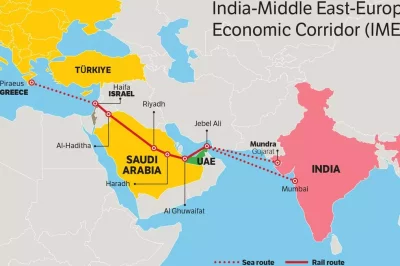India’s ties with the Middle East have historically revolved around three pivotal elements: human resources, remittances, and oil. Moreover, India’s blueprints in the Middle East have been characterized by a careful balancing act, maintaining warm relations with Israel and the Arab states.
Previously, India did not have that kind of leverage in the region. However, since it departed from non-alignment, it has been making partnerships in both economic and political realms via various accords.
These include the I2U2 (a new quadrilateral alliance designed to enhance economic collaboration between Israel, India, the UAE, and the United States), India Middle East Europe Economic Corridor (IMEEC), Comprehensive Economic Partnership Agreements (CEPAs), Double Taxation Avoidance Agreements (DTAA). These developments signal India’s increasing influence and partnerships in the region.
Geopolitical Expansion of India-Middle East Relations:
In the 21st century, geopolitics is crucial in driving global trends, influencing everything from international policies to economic strategies among nations. Therefore, the relationship between India and the Middle Eastern states rapidly extends into new domains beyond the economy, explicitly transcending into the geopolitical arena.
Traditionally, India has been a significant provider of workforce for infrastructural developments in the oil-rich Gulf countries and has, in turn, derived benefits from the massive remittances flowing back home from its workers in the region.
To strengthen this, India has also signed Labor, Manpower Agreements, and Memorandum of Understanding ( MoUs) with GCC countries. The Middle Eastern states have historically been crucial energy suppliers for India.
India’s Look West Policy
The deepening of India-Middle East relations is as much a story of India’s “Look West Policy” emphasized by Prime Minister Narendra Modi.
In 2018, during an address at London’s Central Hall, Modi stated: “Yes, I will go to Israel, and I will even go to Palestine. I will further cooperate with Saudi Arabia, and I will also engage with Iran for India’s energy needs.” This indicates that under Prime Minister Modi, India is firm in its growing involvement with West Asia.
Economic and Trade Agreements
India has deepened a range of agreements with Middle Eastern states, emphasizing its economic, security, and strategic interests.
I2U2
The heads of government of India, Israel, the United Arab Emirates (UAE), and the United States convened the first leaders’ summit on July 14, 2022, to establish the I2U2 Group. This initiative enables Delhi to strengthen trade ties with the Emirates after the sealing of a significant economic agreement and adds impetus to negotiations for a trade agreement with Israel.
The India-Middle East-Europe Corridor
The India-Middle East-Europe Corridor (IMEC) was proclaimed at the 2023 G20 Summit. This corridor possesses considerable potential for enhancing economic integration, trade, and investments. It also promotes collaboration among the participating countries on multiple fronts. Furthermore, this corridor gives India a strategic advantage, enhancing its influence from the Middle East to Europe.
India-UAE Comprehensive Economic Partnership Agreement
The UAE-India CEPA became effective on May 01, 2022. It is a bilateral trade agreement encompassing 90% of India’s exports and services. It is expected to enhance trade by $15 billion over the next five years.
This year, on May 1, 2024, India and the UAE celebrated the second anniversary of CEPA. Since signing a broad trade and investment pact, India has witnessed a 16% boost in bilateral trade over the past two years. Growth has been particularly notable in innovation, energy, and technology.
FICCI Secretary-General S.K. Pathak shared an optimistic outlook: “In the first two years of CEPA’s operation, we have witnessed a remarkable 16.41 percent growth in trade between the two countries. This translates to a significant increase in total trade, from $72.87 billion in 2021-2022 to $84.84 billion in 2022-2023.”
Cultural and Religious Influence
Indian Prime Minister Narendra Modi visited the Middle East in February 2024. His first stop was in the UAE, where he headlined one of his famous Indian diaspora rallies. During his visit, he also inaugurated Abu Dhabi’s first-ever Hindu temple and signed 10 bilateral agreements. This Hindu Temple is a significant marker of India’s growing cultural and religious Influence in the Middle East.
India’s expanding influence is evident through diverse engagements ranging from strategic and economic collaboration to deep cultural and religious integration. Furthermore, these growing relationships are strategically significant amid increasing Chinese influence in the region. By strengthening its presence in the Middle East, India is positioning itself as a counterbalance to China.
Conclusion
The India-Middle East-Europe Corridor (IMECC) initiative can be viewed as an essential part of this strategy, parallel to China’s Belt and Road Initiative (BRI), which is often labeled as “BRI 2.0.” The IMECC promotes regional connectivity and economic integration between India, the Middle East, and Europe.
Thereby, this not only facilitates trade and investment but is also established as a strategic counteraction to China’s expansive geopolitical ambitions. These endeavors highlight India’s growing global stature and commitment to fostering a balanced and inclusive international order.

Atika Hassan is pursuing her MPhil in International Relations from University of the Punjab, Lahore, Pakistan. She loves to explore the fascinating world of international and domestic politics and can be reached out at atikahassan241@yahoo.com







